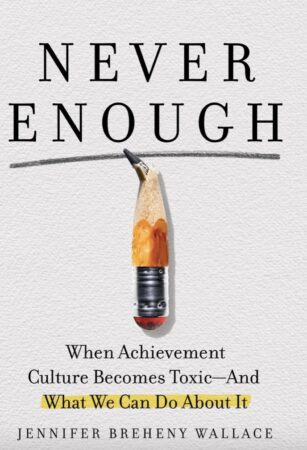The following is an interview by Lisa Heffernan with Jennifer Wallace whose new book, Never Enough: When Achievement Culture Becomes Toxic—And What We Can Do About It, will be released in August, 2023.
LH: What is it about our current culture that has caused achievement pressure to reach a boiling point?
JBW: Critics of modern parenting say that we bring this stress and anxiety on ourselves, that we’re pushing kids too hard, living vicariously through them, and too focused on a narrow definition of success. But, what I found was that there are forces bigger than any one family, school or community that are causing this pressure on parents and kids.
Today’s intensive parenting style isn’t a personal choice that individual families make alone in their living rooms. Modern parents are trying as best they can to adapt to some pretty extraordinary economic changes.
With increasing wealth inequalities, stagnant social mobility, and the competitive threats of globalization, parents fear that without their intense guidance and push, their children may end up “on the wrong side of the divide.” It is an instinctual response to the rising insecurity in our environment.
Back in the 1970s, parents could be more relaxed because there was more slack in the system. Buying a house was more affordable. So were health insurance and education. Today, as one mother put it, it’s like when your baby is born, there’s an elevator that starts going up and if you don’t get on it right away, they’ll be left on the ground floor forever. And as their parent, it will be your fault.
Parents see high achievement as a kind of “safety vest” protecting their kids in such an unknown future. In other words, parents engage in anxious, overly involved parenting—ranking eight-year-olds in soccer, coaching five-year-olds for standardized tests to get into gifted programs—because we are what researchers call “social conduits,” socializing our kids to prepare them for steep economic inequality and the cutthroat competition that awaits them in adulthood.
But, research finds there’s a better way for parents to focus their parental energy to ensure success for their kids in this ever-shifting landscape. It’s not about giving up on our ambition for our kids; it’s about reimagining it.
LH: What prompted you to write a book about achievement pressure?
JBW: It was 2019, and the college admissions scandal had just broken. Parents were criminally charged for racketeering all in an effort to get their kids into a brand-name college. What was going on? I just didn’t buy that parents were so consumed with status and wanting to secure the right bumper sticker for their car. I had a gut instinct that something deeper was going on.
As a mother of three teenagers, I have been trying to make sense of just how much my children’s childhood has changed from when I was growing up: the demands on their time, the pressure when it comes to sports, the very high bar that has been set for what’s considered an achievement.
For my parents and their parents, raising self-sufficient, honorable citizens was the ultimate goal. Today’s “good” parents face a tougher metric: how well do they mold their kids to measure up to a narrow definition of success?
As a journalist, I started digging into what was causing this enormous shift and how it impacted kids and families. For three years, I traveled to communities nationwide – listening to families who had lost a teen to suicide, and interviewing researchers, economists, psychologists and sociologists to understand why achievement culture is more prominent and toxic than ever.
I also found parents, educators, and communities fighting back with grassroots approaches to protecting student mental health. I found practical solutions that parents could do in their homes, schools and wider communities to fight against this excessive pressure.
LH: You’re honest about getting caught up in the pressures of our achievement culture yourself. Tell us some of the stresses you’ve encountered in your own home.
JBW: When my oldest son William, now 17, was in middle school, I was convinced that time was running out for him to find his passion. So many parents had already figured out what makes their child uniquely tick. There was the chess prodigy, the soccer star, and the math whiz. What latent talents were I neglecting in my own three kids?
William had always shown an interest in architecture and design. When we would go to the supermarket, he’d get fixated on things like the metal contraption that cuts the plastic bags in the produce section. When we’d travel, he’d look at the facades and point out unusual designs. Wasn’t this the spark of a passion that I should nurture?
But how can you nurture a love of design in a 10-year-old? So I started googling “Intro to Architecture and Design.” I went down the list and called class after class until one bit. They said they had a class, but it was aimed at upperclassmen in high school. But if I sat next to him, they’d let us enroll.
I remember being so excited when William came home from school. After I told him, he looked me in the eye, and he said: “Mom, I love architecture. Please don’t ruin it for me.”
What I found in researching this book was that I wasn’t alone in feeling anxious about my child falling behind.
LH: You wrote an article for the Washington Post in 2019 on a newly named “at risk” group of children. Can you tell us about that?
JBW: Parents seek out communities with the best public schools to set their kids up for a bright future. But these competitive schools can come at a steep psychological cost to those attending them. In a stunning finding, two national policy reports by our country’s top developmental scientists have named students attending these high-performing public and private schools an “at risk” group – right after kids living in poverty and foster care, recent immigrants, and those with incarcerated parents.
It’s estimated that one in three American students are impacted by this excessive pressure to achieve. This heightened competition has downstream effects, ultimately impacting all children.
In a rare report, the US Surgeon General Vivek Murthy listed the top environmental conditions harming adolescent mental health: poverty, trauma, discrimination and an “excessive pressure to excel” in all areas of their young lives. These pressures students are “at risk” for anxiety, depression, suicide and substance abuse disorders up to six times hugher than national averages. Not every student in these communities is affected and not every school exhibits the same symptoms, but as a group, these students are at a much greater risk for negative mental health outcomes.
With record-low acceptance rates at many top colleges and universities, students feel tremendous pressure to resume-build and to be the best in all aspects of their young lives. Driven students must outcompete each other for a few, coveted spots, whether it’s a seat in AP Calculus or a spot on the debate team. This pits students against each other.
Even activities that were once stress-reducers, like playing a musical instrument or a sport, have become a competitive full-time jobs and a means to an end, that end being a spot at one of the country’s most competitive colleges and then on to a prestigious, high-paying career.
Working hard and achieving is laudable, but when a child’s sense of self-worth is tied to what they achieve, it can cause them to feel anxious or depressed. Anxiety can come from worrying about keeping up or outshining peers, while depression is caused by a failure to achieve.

LH: We’ve talked a bit about the problem, now let’s talk about the solutions. At the heart of the book, you write about the importance of mattering. Can you tell us about that?
JBW: In my research, I searched for the healthy strivers, kids who were doing well despite the pressures in their environment. What, if anything, did they have in common? What did their parents focus on at home? What was school like for them? What were their friendships like?
I found about a dozen things that the healthy achievers I met had in common. As I was looking for a framework to present my findings, I came across a psychological construct called “mattering. “
Mattering was first conceptualized by the legendary social psychologist Morris Rosenberg. He is also the man who brought us the concept of self-esteem. What he found in his research was that kids who enjoyed a healthy level of self-esteem felt like they mattered – to their family, to their friends, to their communities.
Since then, researchers have studied mattering all over the world. It is a universal feeling. After food and shelter, researchers argue that mattering is the driver of all human behavior, for better or for worse. It is what they call a meta-need or an umbrella term, encompassing feelings of belonging, connection, self-determination, fairness, pride, mastery.
When you have a high level of mattering – when you feel like you are valued and known for who you are at your core by your family, friends and community and when you are relied on to add meaningful value to family, friends and community – that leads to thriving.
Too many kids I met, though, felt like their mattering was contingent on their performance. They felt like they mattered more to their parents when they achieved. When mattering is linked to performance, it leads to mental health distress.
Another group of kids I met who weren’t thriving were kids who had a lopsided sense of mattering. They didn’t have time in their schedules or sense of being relied on to add meaningful value to family, friends, and their wider community.
Because they didn’t give back, they lacked social proof that they mattered.
LH: You offer so much practical, actionable advice in the book. Let’s give people a couple of tips you offer in the book. You talk about “making the thinking visible” and give an example of a $20 dollar bill. Can you tell us about that?
JBW: This was advice from a wise mother I interviewed, something she did something clever with her kids whenever they faced a big disappointment or setback, like getting cut from a team or doing poorly on a test despite working hard to underscore the idea that their worth and value isn’t contingent on their performance.
She takes a $20 bill out of her wallet, and asks her child if they want it. Then, she crumples it up, theatrically squashes it on the floor, and dunks it into a glass of water. Then, she holds up that soggy, dirty bill and asks her child: do you still want it?
Then she gets explicit: “Like this $20 bill, our value never changes, even when we have a setback or a failure. Your worth never changes, no matter whether you make the team or not, or get a high grade or not. Your worth is your worth. Period.”
LH: You offer a series of questions in the book of how parents can reflect on the pressure at home. Can you share those with us?
JBW: This is excellent advice I got from Tina Payne Brison. To take the temperature on what messages you’re sending your kids about the importance of achievement, she tells parents to ask themselves four questions:
1) What you spend your money on with regard to your kids?
2) What does your child’s calendar looks like?
3) What you ask your kids about?
4) What you argue with your kids about?
Those four answers tell you a lot about what your child thinks is most important to you and what you value most. It’s often surprising to parents, Brison told me, many parents think that they’re not over-emphasizing achievement and that they’re communicating values about being well-rounded and healthy. But when they look at those four things, they see how their behavior is telling their children a different story
LH: That is wonderful advice. OK, the book is coming out in August, but you’ve arranged for a preorder special: two chapter excerpts, the secrets of the healthy strivers you met, and a list of very practical tips parents can start using today. You’re also offering an exclusive back-to-school webinar you’re co-hosting with psychologist Lisa Damour, author of Untangled and other books, only for readers who pre-order the book. Can you please explain how people can access this exclusive content?
JBW: Yes, I’m so excited to be able to share the Secrets of Healthy Strivers, a guide to the game-changing habits of healthy achievers, and Messages of Mattering for Parents, scripts to introduce and reinforce mattering at home. They are only available when you pre-order the book. They’re not in the book itself. And Lisa Damour and I are going to host a back-to-school webinar about how best to handle achievement pressure and encourage healthy striving.
All you have to do is Pre-order the book at Barnes & Noble, Amazon, or any independent bookseller. Then, head to my website. Plug in your order number. After that, you’ll get all this content sent right to your email. I am so excited to be able to share with parents all that I’ve learned.
More Great Reading:
Favorite Books, Websites and Podcasts for Parents of Teens

 PARENTING TIPS
PARENTING TIPS PREGNANCY
PREGNANCY BABY CARE
BABY CARE TODDLERS
TODDLERS TEENS
TEENS HEALTH CARE
HEALTH CARE ACTIVITIES & CRAFTS
ACTIVITIES & CRAFTS


